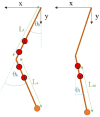MIT-Skywalker: A Novel Gait Neurorehabilitation Robot for Stroke and Cerebral Palsy
- PMID: 26929056
- PMCID: PMC5552172
- DOI: 10.1109/TNSRE.2016.2533492
MIT-Skywalker: A Novel Gait Neurorehabilitation Robot for Stroke and Cerebral Palsy
Abstract
The MIT-Skywalker is a novel robotic device developed for the rehabilitation or habilitation of gait and balance after a neurological injury. It represents an embodiment of the concept exhibited by passive walkers for rehabilitation training. Its novelty extends beyond the passive walker quintessence to the unparalleled versatility among lower extremity devices. For example, it affords the potential to implement a novel training approach built upon our working model of movement primitives based on submovements, oscillations, and mechanical impedances. This translates into three distinct training modes: discrete, rhythmic, and balance. The system offers freedom of motion that forces self-directed movement for each of the three modes. This paper will present the technical details of the robotic system as well as a feasibility study done with one adult with stroke and two adults with cerebral palsy. Results of the one-month feasibility study demonstrated that the device is safe and suggested the potential advantages of the three modular training modes that can be added or subtracted to tailor therapy to a particular patient's need. Each participant demonstrated improvement in common clinical and kinematic measurements that must be confirmed in larger randomized control clinical trials.
Figures









Similar articles
-
On the control of the MIT-skywalker.Annu Int Conf IEEE Eng Med Biol Soc. 2010;2010:1287-91. doi: 10.1109/IEMBS.2010.5626407. Annu Int Conf IEEE Eng Med Biol Soc. 2010. PMID: 21095920
-
MIT-Skywalker: Evaluating comfort of bicycle/saddle seat.IEEE Int Conf Rehabil Robot. 2017 Jul;2017:516-520. doi: 10.1109/ICORR.2017.8009300. IEEE Int Conf Rehabil Robot. 2017. PMID: 28813872
-
[Robotic assisted treadmill therapy in children with cerebral palsy].MMW Fortschr Med. 2009 Oct;151 Suppl 3:123-6. MMW Fortschr Med. 2009. PMID: 20623939 German. No abstract available.
-
[Benefits of robotics in gait rehabilitation in cerebral palsy: A systematic review].Rehabilitacion (Madr). 2020 Apr-Jun;54(2):128-136. doi: 10.1016/j.rh.2020.01.004. Epub 2020 Apr 1. Rehabilitacion (Madr). 2020. PMID: 32370827 Spanish.
-
Robot-aided neurorehabilitation: a robot for wrist rehabilitation.IEEE Trans Neural Syst Rehabil Eng. 2007 Sep;15(3):327-35. doi: 10.1109/TNSRE.2007.903899. IEEE Trans Neural Syst Rehabil Eng. 2007. PMID: 17894265 Free PMC article. Review.
Cited by
-
An Intention-Driven Semi-autonomous Intelligent Robotic System for Drinking.Front Neurorobot. 2017 Sep 8;11:48. doi: 10.3389/fnbot.2017.00048. eCollection 2017. Front Neurorobot. 2017. PMID: 28943849 Free PMC article.
-
Robot-assisted training compared with an enhanced upper limb therapy programme and with usual care for upper limb functional limitation after stroke: the RATULS three-group RCT.Health Technol Assess. 2020 Oct;24(54):1-232. doi: 10.3310/hta24540. Health Technol Assess. 2020. PMID: 33140719 Free PMC article. Clinical Trial.
-
Wearable Ankle Robots in Post-stroke Rehabilitation of Gait: A Systematic Review.Front Neurorobot. 2019 Aug 13;13:63. doi: 10.3389/fnbot.2019.00063. eCollection 2019. Front Neurorobot. 2019. PMID: 31456681 Free PMC article.
-
Treadmill vs. overground walking: different response to physical interaction.J Neurophysiol. 2017 Oct 1;118(4):2089-2102. doi: 10.1152/jn.00176.2017. Epub 2017 Jul 12. J Neurophysiol. 2017. PMID: 28701533 Free PMC article.
-
Biomarkers for rhythmic and discrete dynamic primitives in locomotion.Sci Rep. 2022 Nov 23;12(1):20165. doi: 10.1038/s41598-022-24565-z. Sci Rep. 2022. PMID: 36424422 Free PMC article.
References
-
- Lawrence ES, Coshall C, Dundas R, Stewart J, Rudd AG, Howard R, Wolfe CD. Estimates of the prevalence of acute stroke impairments and disability in a multiethnic population. Stroke. 2001;32(6):1279–1284. - PubMed
-
- Sommerfeld DK, Eek EUB, Svensson AK, Holmqvist LW, von Arbin MH. Spasticity after stroke its occurrence and association with motor impairments and activity Limitations. Stroke. 2004;35(1):134–139. - PubMed
-
- Lloyd-Jones D, Adams RJ, Brown TM, Carnethon M, Dai S, Simone GD, Ferguson TB, Ford E, Furie K, Gillespie C, Go A, Greenlund K, Haase N, Hailpern S, Ho PM, Howard V, Kissela B, Kittner S, Lackland D, Lisabeth L, Marelli A, McDermott MM, Meigs J, Mozaffarian D, Mussolino M, Nichol G, Roger VL, Rosamond W, Sacco R, Sorlie P, Stafford R, Thom T, Wasserthiel-Smoller S, Wong ND, Wylie-Rosett J. Executive Summary: Heart Disease and Stroke Statistics—2010 Update a Report From the American Heart Association. Circulation. 2010 Feb;121(7):948–954. - PubMed
-
- Winter S, Autry A, Boyle C, Yeargin-Allsopp M. Trends in the prevalence of cerebral palsy in a population-based study. Pediatrics. 2002;110(6):1220–1225. - PubMed
-
- Fisher M. New approaches to neuroprotective drug development. Stroke. 2011;42(1) 1:s24–s27. - PubMed
Publication types
MeSH terms
Grants and funding
LinkOut - more resources
Full Text Sources
Other Literature Sources
Medical

